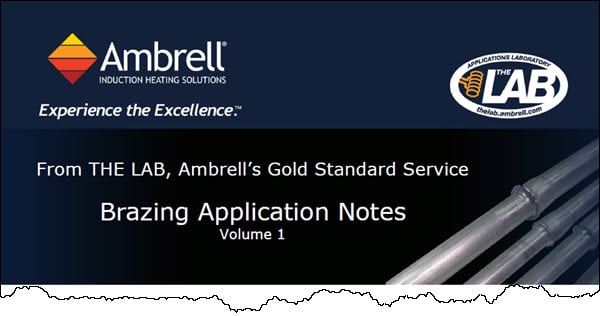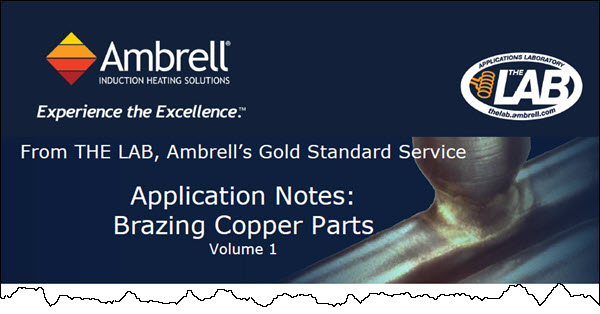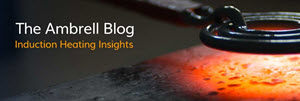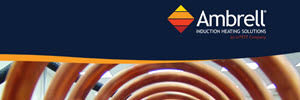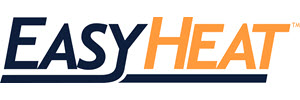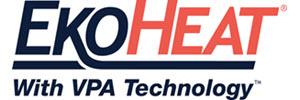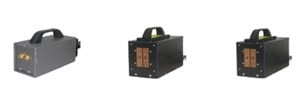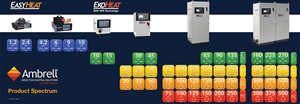Induction Brazing
- Home
- Process Applications
- Brazing
What Is Induction Brazing?
Induction brazing is a process for joining two metals using induction heating with a filler material that melts, flows and wets the metals’ surfaces at a temperature that is lower than the melting temperature of the two metals.
Induction generates an electromagnetic field in a work coil that induces currents in the conductive material of a workpiece placed within or near the coil. Friction from these currents elevates the temperature of the workpieces and filler to be brazed.
brazing Application Notes
Select from our collection of brazing notes, taken from years supporting our customers. Read how we helped to solve their process heating challenges.
 Brazing a Copper Tube and Brass Fitting Assembly
Brazing a Copper Tube and Brass Fitting Assembly
To heat a customer supplied copper tube and brass fitting assembly for a brazing application; the customer, a manufacturer of heat exchangers, had been manually brazing the assemblies.
 Brazing Steel Assemblies (hydraulics)
Brazing Steel Assemblies (hydraulics)
A custom-designed single position multiple-turn oval split helical coil was built to generate the required heating for this brazing application.
 Brazing an Aluminum Tube Assembly
Brazing an Aluminum Tube Assembly
A custom-designed single position multiple-turn pancake coil was built to generate the required heating for this brazing application. Initial tests were conducted to optimize power delivery to the assembly
 Brazing a Carbide and Steel Assembly
Brazing a Carbide and Steel Assembly
A custom-designed single position multiple-turn helical coil was built to generate the required heating for this brazing application. Initial tests were conducted to optimize power delivery.
 Brazing Copper Tubes for a Solar Industry Application
Brazing Copper Tubes for a Solar Industry Application
A custom-designed single position multiple-turn split-helical coil was built to generate the required heating for this brazing application.
A custom designed single position multiple-turn helical coil was built to generate the required heating for the application.
A custom-designed single position multiple-turn helical coil was built to generate the required heating for the application.
 Brazing a Copper Tube & Brass Fitting
Brazing a Copper Tube & Brass Fitting
A custom-designed single position multiple-turn U-shape coil was built to generate the required heating for this brazing application.
 Brazing Copper and Brass Valves
Brazing Copper and Brass Valves
To braze various copper and brass assemblies for a valve manufacturer; they are looking to replace their torch heating process with induction
 Brazing Steel Fittings & Tubes (Hydraulics)
Brazing Steel Fittings & Tubes (Hydraulics)
Braze steel fittings and tubes in an atmosphere to make hydraulic fittings within a targeted heating time of under 150 seconds.
 Brazing Both Ends of a Steel Assembly
Brazing Both Ends of a Steel Assembly
The client wanted to braze both ends of the part concurrently within their time requirements. Induction met the client’s time requirements and is often faster than other heating methods. With induction there is no open flame and with induction’s instant on/off capabilities, it introduces less heat into the work environment.
 Brazing Copper and Brass Fittings (Flange)
Brazing Copper and Brass Fittings (Flange)
How to braze copper tubes and a steel plate for a brazing application; while this is a new process for the client, they also tested the process with a torch
 Steel Nozzle Assembly (Aerospace)
Steel Nozzle Assembly (Aerospace)
Where you can struggle with repeatability with an oven and torch, induction brazing is a more repeatable process. With induction heating, there is no open flame and the benefit of instant on/off capabilities. This introduces less heat into the work environment.
 Brazing Brass and Copper Nozzles
Brazing Brass and Copper Nozzles
To braze copper and brass samples for an application in the aerospace industry, induction heating was used in place of a previously used torch. Induction brazing allows more consistent, higher quality parts.du
 Brazing a Steel Part for the Aerospace Industry
Brazing a Steel Part for the Aerospace Industry
A custom-designed multiple-turn helical coil was built to generate the required heating for a steel cable for the aerospace industry. Induction brazing was used to heat a steel part for a brazing application.
 Brazing, De-brazing Carbide, Steel Plates
Brazing, De-brazing Carbide, Steel Plates
A custom-designed special multiple-turn helical coil was built to generate the required heating to heat a carbide and steel plate assembly for a brazing and de-brazing application in the oil and gas industry.
 Brazing Brass Assembly; Sink Manufacturer
Brazing Brass Assembly; Sink Manufacturer
To heat brass assemblies for a brazing application, the client, who manufactures sink products had been using a torch. Induction heating heated the assembly to temperature and better met the client’s time requirements.
 Brazing a Copper Tube and Steel Plate
Brazing a Copper Tube and Steel Plate
In order to braze copper, a custom-designed single position multiple-turn helical coil was built to generate the required heating for the tube-to-plate brazing application. Initial tests were conducted to optimize the power delivered to the part. Repeatability was a top priority for this client.
 Brazing a Nickel Pin and a Nickel Wire
Brazing a Nickel Pin and a Nickel Wire
A client had been using flame heating to braze a nickel pin and a braided nickel wire. The end-product is a heater assembly. Using induction improved joint quality compared to using flame heating.
 Brazing a Carbide Tip and Magnetic Steel Tube
Brazing a Carbide Tip and Magnetic Steel Tube
To braze carbide inserts into magnetic steel tubes, an inconsistent torch process was replaced with induction brazing equipment. In this application, quality rather than speed was the top priority.b
 Brazing a Steel and Carbide Assembly
Brazing a Steel and Carbide Assembly
To braze a steel and carbide assembly to create a mining bit for the oil and gas industry, this client replaced their torch process with the repeatable and flameless induction brazing technique.
 Braze a Copper Tube and Brass Fitting (fuel containment)
Braze a Copper Tube and Brass Fitting (fuel containment)
How to braze copper using a custom-designed single position multi-turn helical coil built to generate the required heating for the copper brazing application.
 Brazing a Copper Strip Assembly
Brazing a Copper Strip Assembly
The client requested a system that would meet their time objectives which the EKOHEAT easily did, boosting the client's throughput.
 Induction brazing a Steel Tube with External Wire Braid
Induction brazing a Steel Tube with External Wire Braid
The coil selected is not only capable of induction heating the steel 7/8/22 mm tube, but also a smaller tube that the client needs to heat.
 Brazing, De-Brazing Diamond Carbide Inserts
Brazing, De-Brazing Diamond Carbide Inserts
Heat steel cutting bits with diamond-carbide inserts for brazing and de-brazing; the end products are cutting tools
 Brazing a steel and carbide dental assembly
Brazing a steel and carbide dental assembly
This configuratoin achieved the client's objective. The channel coil - specially designed by THE LAB at Ambrell- was critical to the application's success.
 Brazing a brass tube and flange; torch replacement
Brazing a brass tube and flange; torch replacement
Application engineers determined placing a turn that is targeted to the tube inside the part would optimize heating for this application. This heats the tube while the flange is being heated enabling both parts to achieve the required temperature concurrently.
 Brazing a magnetic steel cutting tool with induction
Brazing a magnetic steel cutting tool with induction
Induction heating rapidly heats the steel parts to the required temperature, especially with the EKOHEAT's Auto Tap feature. The Ambrell Applications Lab used their expertise to create the right solution for the system and the system hardware.
 Brazing a steel and copper strip to carbide
Brazing a steel and copper strip to carbide
Induction heating of the steel took less than 30 seconds, is highly repeatable and there is no open flame, clear benefits over flame heating. it a safer method of heating than torch heating
 Induction brazing a rectangular steel part
Induction brazing a rectangular steel part
Induction heating of the steel took 30 seconds (or less), which can't be matched when using a torch. This client was using an old induction system from another vendor, and the Ambrell system provided considerably faster heating
The client had been using a torch, which took 50 seconds instead of 30; induction brazing the copper increased repeatability and in turn boosted part quality. Also, there is no open flame which makes it a safer method of heating than torch heating
 Copper block & carbide; contact assembly
Copper block & carbide; contact assembly
Induction completed the carbide brazing process more rapidly than an oven, delivering heat exactly where it's needed, operating instant on/instant off
 Induction heating steel coupons and carbide cutters for brazing and de-brazing
Induction heating steel coupons and carbide cutters for brazing and de-brazing
The first coupon that was heated had a 16 mm (0.63) diameter cutter, so removal of the cutter was the objective. The part was coated in black flux and inserted into the coil...
 Brazing aluminum adaptors to the end of aluminum tubes
Brazing aluminum adaptors to the end of aluminum tubes
To increase production, a multi-position coil was recommended so multiple parts could be heated while maintaining a cycle time of 55 seconds, delivering consistent joint quality, which a torch often doesn't deliver.
 Brazing a nickel sleeve to a copper mast
Brazing a nickel sleeve to a copper mast
To heat a nickel sleeve and a copper mast for a brazing application to create a pitot tube for the aerospace industry
 Brazing a brass screw cap and a steel tube
Brazing a brass screw cap and a steel tube
Induction heating enables brazing the cap and tube to be completed at a rate of 15 seconds per part while delivering consistent joint quality in a safer environment which a torch often can't offer...
 Brazing a stainless steel fitting to a stainless steel capillary tube
Brazing a stainless steel fitting to a stainless steel capillary tube
Induction enables consistent joint quality in about 35 seconds, which a torch often doesn't deliver; in this case this is the primary reason for switching to induction
 Brazing a steel coupler and a steel wire
Brazing a steel coupler and a steel wire
Induction heating enabled the brazing process to be completed within 30 seconds. The client was using a torch, and induction offers superior repeatability with no open flame and delivering heat only where it's required...
 Brazing brass tube and fitting assemblies
Brazing brass tube and fitting assemblies
The brass tubes and fittings heated to required temperature far more quickly than with customer's torch method, resulting in improved part quality and introducing less heat into the production environment...
 Brazing carbide tips to a steel cutter
Brazing carbide tips to a steel cutter
The cutter was held in a vice and the coil was presented to heat the assembly. A ceramic rod was used to press the carbide tip onto steel cutter during brazing.
 Brazing a copper tube assembly
Brazing a copper tube assembly
The proposed system is capable of heating a wide variety of tube assemblies, is light enough to be used on a cart and is able to meet the client's time/productivity objectives
 Brazing a brass tube assembly (valve manufacturing)
Brazing a brass tube assembly (valve manufacturing)
With the recommended coil configuration, the cycle time turned out to be 25% less than what the client was targeting, resulting in increased production efficiency; a good braze joint was formed, and induction's consistency and repeatability proved valuable
 How to braze three copper tubes to create a four-way valve
How to braze three copper tubes to create a four-way valve
Due to the use of a higher power system, speed expectations were exceeded and improved over the client's previous method, which was torch heating. A good copper braze joint was formed, and induction's consistency and repeatability proved valuable. Induction brazing doesn't employ an open flame, which results in a safer work environment
 Brazing copper tubes to a brass manifold block
Brazing copper tubes to a brass manifold block
The proposed process met the client's time objective, and is faster than oven heating.
 Brazing copper and brass valve assemblies (HVAC)
Brazing copper and brass valve assemblies (HVAC)
The copper tube (1/8/3.2mm) is inserted into the flared copper tube (1/4/6.4mm). Two braze rings are placed on the copper tubes and the power is applied....
 Brazing steel drill bits (aerospace)
Brazing steel drill bits (aerospace)
The client wanted to heat three parts concurrently, and this process allowed up to five parts to be heated concurrently...
 Brazing steel flange and shaft assemblies (aerospace and automotive applications)
Brazing steel flange and shaft assemblies (aerospace and automotive applications)
Induction brazing is a repeatable process that isn't as labor intensive as a flame often is. The process can heat the assembly rapidly and more energy-efficiently than a torch without the safety risks that come with an open flame
 Brazing two fittings and a helical tube to create a mount
Brazing two fittings and a helical tube to create a mount
The client had been using a torch, and was dealing with inconsistent results that impacted part quality. Induction heats the assembly more quickly than the torch..
 Brazing tubes and fittings for an air conditioning unit for the off-road market
Brazing tubes and fittings for an air conditioning unit for the off-road market
Clients were using an oven, and because the whole part was being heated and essentially annealed, it created problems with the part. Induction only heats the braze area, and resolves that issue...
 Brazing a steel and brass immersion heating element
Brazing a steel and brass immersion heating element
Induction results in faster heating than a torch with faster, multipart heating to increase output...
 Brazing an aluminum assembly for a bicycle manufacturing application
Brazing an aluminum assembly for a bicycle manufacturing application
For this aluminum bicycle tube brazing application, induction heating delivers more repeatable and consistent results, while cutting client's heating time in half when compared to using a torch...
 Brazing a magnetic steel tube and steel mating assembly
Brazing a magnetic steel tube and steel mating assembly
Heating a 0.437 (11.1) in(mm) outside diameter magnetic steel tube and steel mating assembly to temperature for a brazing application to create an oil tube for the railroad industry...
![image: Brazing an aluminum manifold [air conditioning]](https://www.ambrell.com/hs-fs/hubfs/ambrell-images/Applications/Thumbs/brazing_74.jpg?width=95&height=95&name=brazing_74.jpg) Brazing an aluminum manifold [air conditioning]
Brazing an aluminum manifold [air conditioning]
Precise, repeatable heating: The client wanted more precise and repeatable heating than a torch could deliver, which induction was able to achieve..
 Brazing a steel tube and fitting to create an automotive valve
Brazing a steel tube and fitting to create an automotive valve
Customer's client was unhappy with the results from MIG welding, which drove them to look at induction as an alternative process. Induction heating proved to be a fast, repeatable heating method for the application...
 Brazing a carbide ball to a spring to create a part that controls the armature position in a motor
Brazing a carbide ball to a spring to create a part that controls the armature position in a motor
To heat a tungsten carbide ball and steel rod that acts as a spring to 1300 °F (704 °C) within five seconds for a brazing application to create a part that governs the armature position in a motor...
 Brazing a steel rod and sensor housing assembly
Brazing a steel rod and sensor housing assembly
To heat a steel rod and housing to 1400 °F (760 °C) within 30 seconds for a brazing application to create an assembly for a sensor...
 Heat a steel block with a cutout for carbide for a brazing application
Heat a steel block with a cutout for carbide for a brazing application
Induction delivers improved quality and repeatability; client was using a torch and induction offered more precise, repeatable heating. In addition, this allowed the client to achieve the targeted heating time of 60 seconds, faster than what the torch could deliver...
 Brazing a copper elbow tube assembly
Brazing a copper elbow tube assembly
In this copper brazing process, induction offers more precise, repeatable heating than current flame process...
 Brazing copper tubing and brass fittings for aerospace parts
Brazing copper tubing and brass fittings for aerospace parts
Induction heating achieves superior process repeatability when compared to a brazing torch and a more predictable aerospace parts which enhances quality..
 Brazing a steel tube and fitting assembly
Brazing a steel tube and fitting assembly
Induction heating is used to braze a steel connector onto a steel tube to create a hydraulic component. ...
 Brazing stainless steel medical tool parts into a coupling
Brazing stainless steel medical tool parts into a coupling
Induction heating is used to achieve client's goal to braze both stainless steel parts as quickly as possible with maximum repeatability...
A tube assembly is heated to the desired braze temperature in 20-25 seconds, which achieves the client's targeted cycle time of less than 30 seconds...
 Brazing a magnetic steel rotor assembly
Brazing a magnetic steel rotor assembly
Induction is proposed to replace a hand-operated flame process requiring operator training and expertise. Induction heating delivers a precise, repeatable and reliable process. Improved joint quality is coupled with simplified operation...
 Brazing carbide insert to steel pipe gripper chuck
Brazing carbide insert to steel pipe gripper chuck
Induction heating is proposed to braze carbide inserts into steel blocks in the assembly of pipe gripper chuck. To replace a hand/flame process, delivering significant reduction in per-part cycles...
 Brazing a copper pipe assembly seam
Brazing a copper pipe assembly seam
The customer is seam brazing copper pipes together. They will reduce the brazing of the seam down to 15-30 seconds.This customer is currently using a torch, but is not getting uniform quality
 Brazing a pressure switch base assembly
Brazing a pressure switch base assembly
Induction heating provides hands-free heating that involves no operator skill for manufacturing, even distribution of heating precise and controllable heat
 Brazing brass and steel for valves and end plugs
Brazing brass and steel for valves and end plugs
The customer is currently using a torch to complete the braze joints. They wish to improve repeatability for a better process.
 Brazing temperature sensor assemblies
Brazing temperature sensor assemblies
A five-turn two-position helical coil is used for this brazing application. Each coil acts individually and the coils are not designed to heat simultaneously...
 Brazing Copper Tubes to a Braided Stainless Steel Hose
Brazing Copper Tubes to a Braided Stainless Steel Hose
Customer is currently using flame and a highly paid operator to complete this application. With an induction system, the customer can save approximately $20,000/year in operator cost alone, not factoring in any energy savings.
 Brazing two aluminum pipes to an aluminum evaporator core
Brazing two aluminum pipes to an aluminum evaporator core
The customer is replacing a flame process which can burn away the thin flange at the joint area and create scrap parts. By switching to induction for this application the customer is decreasing their scrap parts and also increasing their quality and production rate...
 Brazing brass bellow assemblies for pneumatic regulators
Brazing brass bellow assemblies for pneumatic regulators
Customer is replacing flame with induction to braze/solder these parts. While they are not looking to increase their production, they are looking for a repeatable and reliable process...
 Brazing a stainless steel shaft to a carbide for a digger used in mining
Brazing a stainless steel shaft to a carbide for a digger used in mining
A three turn helical coil is used to braze the carbide to the shaft. The steel shaft is fluxed and the braze shim placed on top. The carbide tip is fluxed and placed on top of the shim, lining up the countersunk hole in the carbide. The hole is not fluxed because the flux outgases and causes the carbide to build up pressure and attempt to repel from the shaft...
 Brazing a small gas delivery assembly used to manufacture needles
Brazing a small gas delivery assembly used to manufacture needles
This is a new part for the customer and they are developing the manufacturing process for it. The customer is interested in using induction heat for their process because they are looking for finished parts which are clean and not contaminated by any flux material. By using induction to braze the part and by doing the braze under a hydrogen atmosphere, the customer can produce brazed parts with no oxidation...
 Brazing copper and steel tube combinations for refrigeration and air conditioning
Brazing copper and steel tube combinations for refrigeration and air conditioning
Customer is currently using flame brazing in a large facility for this application and will gain safety benefits with induction such as no hazardous fumes or open flames...
 Brazing a spray bar assembly used for powder coating
Brazing a spray bar assembly used for powder coating
Customer is currently outsourcing this application. By bringing in-house they will save on inventory build-up, transportation cost, time-to-customer and money. Customer found Ambrell on the web and liked the idea that Ambrell's application lab can prove capability before purchasing.....
 Brazing vertical copper bars to a copper slip ring for refurbishing large motor assemblies
Brazing vertical copper bars to a copper slip ring for refurbishing large motor assemblies
A three-turn helical coil is used to heat the slip ring. Power is applied for 25 minutes to bring the ring up to brazing temperature. The slip ring is then held at temperature as the self locating 52 vertical bars are brazed into place...
 Brazing copper cable and block assembly for generator repairs
Brazing copper cable and block assembly for generator repairs
A three-turn helical combination channel coil is used to heat the assembly. The assembly is placed in the coil with a thin ceramic paper placed between the coil and copper assembly...
 Brazing aluminum electrical lug assembly
Brazing aluminum electrical lug assembly
A five turn helical coil is used to braze the assembly. The parts are assembled and placed in the coil. Power is applied and a braze stick is used to braze the two parts in 25-30 seconds...
 Brazing a stainless steel shaft to a carbide cone for a gripper
Brazing a stainless steel shaft to a carbide cone for a gripper
A three-turn helical coil is used to braze the carbide to the stainless steel shaft. A silver solder washer is placed over the post on the shaft, the carbide is placed on the washer and flux is applied...
 Brazing a copper pivot assembly
Brazing a copper pivot assembly
A three-turn helical coil is used to heat the base of the assembly. The copper uprights and two braze shims are placed in the grooves in the base and black flux is applied...
A two turn C shaped coil is used to braze the faucet assembly. The braze rings are placed at the joint, the parts assembled and fluxed...
 Brazing a steel piston valve assembly
Brazing a steel piston valve assembly
A five turn pancake coil is used to braze the piston valve and steel plate. The assembly was heated for 10 minutes to flow the braze and join the two pieces...
 Brazing a steel die into a wire drawing guide
Brazing a steel die into a wire drawing guide
A two-turn helical coil is used for brazing the assembly. Two different bonding agents are tested for the brazing application. The first bonding agent used is braze paste. The assembly is heated to 1382 °F (750 °C) and is brazed in 45 seconds....
 Braze a thin walled tube to a steel cap in a hydrogen atmosphere
Braze a thin walled tube to a steel cap in a hydrogen atmosphere
A single turn helical coil is used to heat the quartz tube and the tube assembly. The tube assembly is held in place inside the quartz tube by a copper fixture and hydrogen is fed into the quartz tube...
 Braze two positions on a stainless steel manifold simultaneously
Braze two positions on a stainless steel manifold simultaneously
A dual six turn split helical coil is used to simultaneously braze the manifold...
 Braze a carbide tip to steel cutting tool
Braze a carbide tip to steel cutting tool
A split helical coil is used to heat the carbide & circular steel cutter evenly for the brazing application. The circular steel cutter is placed in a vise and the carbide and braze shim are placed onto the tooth...
 Braze a mount lead to a ferrule in a PAR light bulb assembly for automobiles
Braze a mount lead to a ferrule in a PAR light bulb assembly for automobiles
A split helical coil heats 2-3 ferrules at a time. The ferrules are filled with flux and the mount leads are placed inside the ferrules...
 Heat a compacted litz wire bundle for stripping
Heat a compacted litz wire bundle for stripping
A three turn helical coil is used for the wire stripping process. The litz wire bundle is placed in the coil for 3 seconds to strip the lacquer 0.75 (19mm) from the end of the bundle. The wire bundle is then scraped with a metal brush to remove the burnt lacquer...
 Braze electrical contacts to brass and copper bus
Braze electrical contacts to brass and copper bus
A five turn split helical coil is used to heat the assembly. The parts are placed 90° to the coil between the top turn and second turn with braze shims and flux.
 Braze a diamond carbide tip onto band saw blade
Braze a diamond carbide tip onto band saw blade
A single turn helical coil is used for this brazing process. The saw blade and diamond carbide tip are placed in the coil...
 Braze a stainless steel braided hose to copper elbow for flexible hosing
Braze a stainless steel braided hose to copper elbow for flexible hosing
A two turn helical coil is used to heat the braided hose assembly. Braze rings are placed...
 Braze an end plug on a stainless steel car grill
Braze an end plug on a stainless steel car grill
A three turn square shaped helical coil is used to heat the end of the grill. End plugs are inserted into the grill and the assembly is inserted into the coil for 30 seconds.
 Brazing joint on pressurized heater connectors
Brazing joint on pressurized heater connectors
Brazing a joint between a copper lug and nickel plated copper pins on a pressurized heater connector.
 Brazing steel mold for golf ball dimple insert
Brazing steel mold for golf ball dimple insert
Induction heating provides a no-flame process with reliable, repeatable, non contact and energy efficient heat in minimal time.
 Heat aluminum for brazing an automotive assembly
Heat aluminum for brazing an automotive assembly
A multi turn pancake coil is used to heat the joint between the aluminum tubing and boss. The joint heats to temperature in 1.5 minutes and the braze ring melts forming a clean brazed joint.
 Brazing stainless steel orthodontic begg brackets
Brazing stainless steel orthodontic begg brackets
A two turn oblong helical coil is designed to heat the steel brackets which are sandwiched between the two pieces of graphite.
 Brazing automotive tube assemblies
Brazing automotive tube assemblies
A four turn split helical coil is used to heat the steel assembly to 1400°F (760°C) for 85 seconds. The coil design allows for the steel fitting to expand away from the steel tube which allows braze to flow through the joint.
 Brazing carbide teeth to steel pipe jaw section
Brazing carbide teeth to steel pipe jaw section
Induction heating provides hands-free heating that involves no operator skill for manufacturing, consistent, repeatable aesthetically pleasing brazes with even distribution of heating
 Braze a refrigeration tube coil assembly
Braze a refrigeration tube coil assembly
Induction heating provides the ability to direct heat only to the required zone, coil geometry which allows for easy loading and unloading of finished parts and the ability of coil to be used with water bath process allows for stability of the o-ring
 Brazing stainless steel tree injector
Brazing stainless steel tree injector
Induction heating provides even distribution of heating, even flow of braze alloy for an aesthetically pleasing bond and system flexibility allows for the same unit to be used for two different applications which is a cost saving.
 Braze four copper bus bars together
Braze four copper bus bars together
A three-turn helical coil is used to heat the assembly. Three braze shim preforms are placed between the plates and white flux is applied to the assembly
 Brazing a carbide and steel shank for a plug guage
Brazing a carbide and steel shank for a plug guage
Induction heating provides hands-free brazing which requires no special operator skills for manufacturing, precise, even heat is applied and is divided equally, between the shank and the carbide, providing an even flow of the braze alloy as the parts reach brazing temperatures.
 Braze steel O-ring Face Seal fittings to a steel tube
Braze steel O-ring Face Seal fittings to a steel tube
A four-turn 2.75 inch (7.0 cm) ID helical coil is used for heating both the steel tube and the ORFS sleeve or the ORFS male connector.
 Steel-carbide brazing cutting tool
Steel-carbide brazing cutting tool
The body shim and carbide are cleaned and braze flux as applied to the entire surface of the assembly. The parts are placed together in the induction coil.
 Brazing carbide to steel for a surgical device
Brazing carbide to steel for a surgical device
Compared to a stick-fed flame braze heating, induction heating provides consistently higher quality joints. This is critical for medical applications.
 Brazing a Plumbing Union in Tight Quarters
Brazing a Plumbing Union in Tight Quarters
Induction provides a reliable braze joint obtained under limited-access conditions, energy is applied only to the joint; little energy is lost to surrounding parts and flame is not used; no bottled gasses required
induction heats only the material within the coil; no energy is wasted heating the surrounding materials and air; no flame or gasses required for heating
 Brazing Faucet Components, Assemblies
Brazing Faucet Components, Assemblies
Three helical coils are used separately to braze a range of provided parts. Parts are assembled with flux and a braze alloy and then heated.
 Brazing Brass Fitting to Copper Tube
Brazing Brass Fitting to Copper Tube
For larger copper tube assemblies, the same process is used, but the braze alloy is stick-fed to the joint to prevent the alloy from flowing out of the joint.
 Brazing Carbide Tips to a Meat Cutter
Brazing Carbide Tips to a Meat Cutter
Due to the size of the induction coil, the process allows for precise placement of the carbides on the steel shanks
 Brazing Copper Fittings to Refrigeration Valve
Brazing Copper Fittings to Refrigeration Valve
With induction, energy is applied only to the zone to be heated heating of the joint/braze is uniform and repeatable
 Brazing a Cutting Tool Assembly
Brazing a Cutting Tool Assembly
Two sets of parts are placed in the individual coils. Braze preforms are placed on the cone at the joint.
 Brazing carbide rotary file to high speed steel shanks
Brazing carbide rotary file to high speed steel shanks
A multi-turn helical coil is used. The part is heated to determine the time required to reach the desired temperature and required heat pattern. I
Induction heating delivers reduced ring warping compared to furnace heating and decreased cycle time due to reduced ramp-up and cooldown times
 Brazing a carbide shaft to steel tube
Brazing a carbide shaft to steel tube
Induction heating provides even, precise heat. Precise directed heat is required for the solder braze to flow evenly around the part to assure a good joint.
 Brazing Brass Ship Fittings for Repair
Brazing Brass Ship Fittings for Repair
The coil allows heating at the best possible efficiency which reduces the cycle time and the conducted heat along the brass tubes.
 Brazing a Bourdon Tube Assembly
Brazing a Bourdon Tube Assembly
To braze a thin copper oval tube to a brass fitting at 1400 ° F and to cap the other end of the copper tube with a brass plate.
To heat copper ‘T’ assemblies to 1400(760) ºF(ºC) for brazing
 Braze Copper Tube to Brass Fitting
Braze Copper Tube to Brass Fitting
To use induction heating to braze a copper tube to a brass fitting using a preform braze wire.
 Brazing steel orthodontic parts
Brazing steel orthodontic parts
A four turn helical coil is used to heat parts. Brazing paste is applied to orthodontic parts with a syringe...
 Brazing an Eyeglass Frame Assembly
Brazing an Eyeglass Frame Assembly
Goal is to achieve quality braze joints on the nose bridge, brow bridge and nose piece.
 Brazing Turbine Blades with Nickel
Brazing Turbine Blades with Nickel
To heat an inconel turbine blade in a vacuum to 2000°F and hold temperature for five minutes for a nickel brazing application.
To heat a steel tip and shank assembly to 1300°F (704°C) within 3 seconds for brazing with induction heating instead of torch brazing.
 Brazing Copper J Tube into Fittings
Brazing Copper J Tube into Fittings
To braze a copper tube ( 3/8 in OD by 2-4 in long) into a 3/8 in fitting in less than 10 seconds.
 Brazing Oil Suction Assembly with Copper Ring
Brazing Oil Suction Assembly with Copper Ring
To heat an oil suction assembly (steel tubing and filter cap) to 1,850°F (1010°C) within 15 seconds for a brazing application.
 Brazing Copper Tube Assemblies
Brazing Copper Tube Assemblies
To heat a copper tube assembly in an inert atmosphere to 1450°F within 45 seconds for brazing without flux or acid wash clean-up.
 Brazing Hydraulic Hose Assemblies
Brazing Hydraulic Hose Assemblies
To heat a steel hydraulic hose fitting in an inert atmosphere to 2200°F within 7 seconds for brazing without any carbon buildup.
 Brazing Stainless Steel Conduit to a Ferrule and Elbow Assembly
Brazing Stainless Steel Conduit to a Ferrule and Elbow Assembly
To heat a stainless steel conduit, ferrule and elbow assembly to 1400°F (760°C) within 20 seconds for brazing.
A C-shaped steel susceptor is used to ensure even heating and for ease of loading and unloading the samples.
 Brazing Carbide Tips on Drill Bits
Brazing Carbide Tips on Drill Bits
A brazing temperature of 1900°F was reached through the use of a unique 4 turn helical coil. D
Benefits of Brazing with Induction
Induction brazing delivers precise, localized heat, increases production rates with faster heating cycles and reduces defect rates with repeatable, reliable heating, eliminating variability from part to part, while maintaining metallurgical characteristics of the individual metals. No need for open flame or a batch process.
Can induction be used to heat carbon fibers?
Induction has been used for carbon fibers all along. It depends how the fibers are layered though. If they’re all in one direction, then the heating isn’t very good and it’s not viable. But if they are woven and have a crisscross pattern, then they form electrical current paths that can be utilized by induction. So the carbon fiber layout is vital.
Is induction more energy efficient?
Induction heating efficiency is derived from the following: selective heating, energy produced directly inside the metal without the aid of a transfer medium, and the ability to insulate the hot part from losing its heat to the environment.
Is induction brazing used in the manufacture of heat pumps?
Yes, many of the components assembled in the manufacture of a typical heat pump can be brazed or soldered using induction heating systems.
Must coils be custom fitted to workpieces?
A coil used to heat a 30in workpiece can certainly be used to heat a 10 in workpiece given the following two criteria. First there should be enough spare capability in the power supply to overcome the coupling loss to the 10 in workpiece in the larger coil. Second, the time to heat the smaller workpiece may be much longer given the poor coupling to the part.
Can induction be used to heat liquid flowing in tubes?
Yes, induction heating is routinely used to heat fluids flowing through metal tubes. Ambrell has provided solutions to numerous such applications.
Get 10 Brazing Application Notes
We have collected 10 of THE LAB's most popular brazing application notes to help you understand the many ways induction heating can improve your precision brazing process.
Get 10 Copper Brazing Application Notes
We have collected 10 of THE LAB's most popular copper parts brazing application notes to help you understand the many ways induction heating can improve your precision copper parts brazing process.
From our blog
The Benefits of Using Induction Heating for BrazingMore induction brazing resources
AMBRELL CORPORATION
1655 Lyell Avenue
Rochester, NY 14606
United States
F: +1 585 889 4030
AMBRELL B.V.
Holtersweg 1
7556 BS Hengelo
The Netherlands
AMBRELL Ltd.
Unit 6, Space Business Centre
Tewkesbury Road
Cheltenham, GLOS, GL51 9FL
United Kingdom
F: +31 546 788 154


 Brazing Fishhooks
Brazing Fishhooks Brazing Copper Bussbars
Brazing Copper Bussbars How to braze a copper tube
How to braze a copper tube Brazing steel tube fittings
Brazing steel tube fittings Brazing brass faucet assembly
Brazing brass faucet assembly Brazing a Brass Trap Block
Brazing a Brass Trap Block Brazing Diamond Drill Inserts
Brazing Diamond Drill Inserts Brazing Copper ‘T’ Assemblies
Brazing Copper ‘T’ Assemblies Brazing steel dental tools
Brazing steel dental tools  Brazing a heat-sensing probe
Brazing a heat-sensing probe